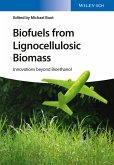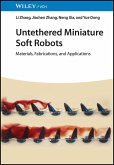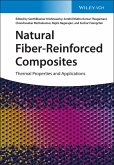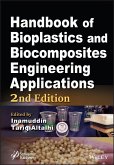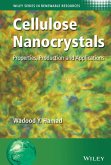Cellulose Science and Technology (eBook, PDF)
Chemistry, Analysis, and Applications
Redaktion: Rosenau, Thomas; Hell, Johannes; Potthast, Antje
181,99 €
181,99 €
inkl. MwSt.
Sofort per Download lieferbar

0 °P sammeln
181,99 €
Als Download kaufen

181,99 €
inkl. MwSt.
Sofort per Download lieferbar

0 °P sammeln
Jetzt verschenken
Alle Infos zum eBook verschenken
181,99 €
inkl. MwSt.
Sofort per Download lieferbar
Alle Infos zum eBook verschenken

0 °P sammeln
Cellulose Science and Technology (eBook, PDF)
Chemistry, Analysis, and Applications
Redaktion: Rosenau, Thomas; Hell, Johannes; Potthast, Antje
- Format: PDF
- Merkliste
- Auf die Merkliste
- Bewerten Bewerten
- Teilen
- Produkt teilen
- Produkterinnerung
- Produkterinnerung

Bitte loggen Sie sich zunächst in Ihr Kundenkonto ein oder registrieren Sie sich bei
bücher.de, um das eBook-Abo tolino select nutzen zu können.
Hier können Sie sich einloggen
Hier können Sie sich einloggen
Sie sind bereits eingeloggt. Klicken Sie auf 2. tolino select Abo, um fortzufahren.

Bitte loggen Sie sich zunächst in Ihr Kundenkonto ein oder registrieren Sie sich bei bücher.de, um das eBook-Abo tolino select nutzen zu können.
This book addresses both classic concepts and state-of-the-art technologies surrounding cellulose science and technology. Integrating nanoscience and applications in materials, energy, biotechnology, and more, the book appeals broadly to students and researchers in chemistry, materials, energy, and environmental science. . Includes contributions from leading cellulose scientists worldwide, with five Anselm Payen Cellulose Award winners and two Hayashi Jisuke Cellulose Award winners . Deals with a highly applicable and timely topic, considering the current activities in the fields of…mehr
- Geräte: PC
- mit Kopierschutz
- eBook Hilfe
Andere Kunden interessierten sich auch für
![Cellulose Science and Technology (eBook, ePUB) Cellulose Science and Technology (eBook, ePUB)]() Cellulose Science and Technology (eBook, ePUB)181,99 €
Cellulose Science and Technology (eBook, ePUB)181,99 €![Biofuels from Lignocellulosic Biomass (eBook, PDF) Biofuels from Lignocellulosic Biomass (eBook, PDF)]() Michael BootBiofuels from Lignocellulosic Biomass (eBook, PDF)120,99 €
Michael BootBiofuels from Lignocellulosic Biomass (eBook, PDF)120,99 €![Untethered Miniature Soft Robots (eBook, PDF) Untethered Miniature Soft Robots (eBook, PDF)]() Li ZhangUntethered Miniature Soft Robots (eBook, PDF)124,99 €
Li ZhangUntethered Miniature Soft Robots (eBook, PDF)124,99 €![Natural Fiber-Reinforced Composites (eBook, PDF) Natural Fiber-Reinforced Composites (eBook, PDF)]() Natural Fiber-Reinforced Composites (eBook, PDF)144,99 €
Natural Fiber-Reinforced Composites (eBook, PDF)144,99 €![High-Performance Materials from Bio-based Feedstocks (eBook, PDF) High-Performance Materials from Bio-based Feedstocks (eBook, PDF)]() High-Performance Materials from Bio-based Feedstocks (eBook, PDF)153,99 €
High-Performance Materials from Bio-based Feedstocks (eBook, PDF)153,99 €![Handbook of Bioplastics and Biocomposites Engineering Applications (eBook, PDF) Handbook of Bioplastics and Biocomposites Engineering Applications (eBook, PDF)]() Handbook of Bioplastics and Biocomposites Engineering Applications (eBook, PDF)188,99 €
Handbook of Bioplastics and Biocomposites Engineering Applications (eBook, PDF)188,99 €![Cellulose Nanocrystals (eBook, PDF) Cellulose Nanocrystals (eBook, PDF)]() Wadood Y. HamadCellulose Nanocrystals (eBook, PDF)110,99 €
Wadood Y. HamadCellulose Nanocrystals (eBook, PDF)110,99 €-
-
-
This book addresses both classic concepts and state-of-the-art technologies surrounding cellulose science and technology. Integrating nanoscience and applications in materials, energy, biotechnology, and more, the book appeals broadly to students and researchers in chemistry, materials, energy, and environmental science. . Includes contributions from leading cellulose scientists worldwide, with five Anselm Payen Cellulose Award winners and two Hayashi Jisuke Cellulose Award winners . Deals with a highly applicable and timely topic, considering the current activities in the fields of bioeconomies, biorefineries, and biomass utilization . Maximizes readership by combining fundamental science and application development
Dieser Download kann aus rechtlichen Gründen nur mit Rechnungsadresse in D ausgeliefert werden.
Produktdetails
- Produktdetails
- Verlag: John Wiley & Sons
- Erscheinungstermin: 3. Dezember 2018
- Englisch
- ISBN-13: 9781119217626
- Artikelnr.: 54775638
- Verlag: John Wiley & Sons
- Erscheinungstermin: 3. Dezember 2018
- Englisch
- ISBN-13: 9781119217626
- Artikelnr.: 54775638
- Herstellerkennzeichnung Die Herstellerinformationen sind derzeit nicht verfügbar.
Thomas Rosenau, PhD, is a professor at BOKU University Vienna, holding the Chair of Wood, Pulp and Fiber Chemistry and heading both the Division of Chemistry of Renewable Resources and the Austrian Biorefinery Center Tulln. Antje Potthast, PhD, is a professor in the Department of Chemistry and is the deputy head of both the Division of Chemistry of Renewable Resources and the Austrian Biorefinery Center Tulln. Johannes Hell, PhD, is a technical manager at a Viennese chocolate factory.
Author Biography xv
List of Contributors xvii
Preface xxiii
Acknowledgements xxv
1 Aminocelluloses - Polymers with Fascinating Properties and Application Potential 1
Thomas Heinze, Thomas Elschner, and Kristin Ganske
1.1 Introduction 1
1.2 Amino-/ammonium Group Containing Cellulose Esters 2
1.2.1 (3-Carboxypropyl)trimethylammonium Chloride Esters of Cellulose 2
1.2.2 Cellulose-4-(N-methylamino)butyrate (CMABC) 7
1.3 6-Deoxy-6-amino Cellulose Derivatives 9
1.3.1 Spontaneous Self-assembling of 6-Deoxy-6-amino Cellulose Derivatives 10
1.3.2 Application Potential of 6-Deoxy-6-amino Cellulose Derivatives 13
1.4 Amino Cellulose Carbamates 21
1.4.1 Synthesis 21
1.4.2 Properties 22
Acknowledgment 24
References 24
2 Preparation of Photosensitizer-bound Cellulose Derivatives for Photocurrent Generation System 29
Toshiyuki Takano
2.1 Introduction 29
2.2 Porphyrin-bound Cellulose Derivatives 31
2.3 Phthalocyanine-bound Cellulose Derivatives 34
2.4 Squaraine-bound Cellulose Derivative 40
2.5 Ruthenium(II) Complex-bound Cellulose Derivative 42
2.6 Fullerene-bound Cellulose Derivative 44
2.7 Porphyrin-bound Chitosan Derivative 45
2.8 Conclusion 47
References 47
3 Synthesis of Cellulosic Bottlebrushes with Regioselectively Substituted Side Chains and Their Self-assembly 49
Keita Sakakibara, Yuji Kinose, and Yoshinobu Tsujii
3.1 Introduction 49
3.2 Strategy for Accomplishing Regioselective Grafting of Cellulose 52
3.3 Regioselective Introduction of the First Polymer Side Chain 55
3.3.1 Introduction of Poly(styrene) at O-2,3 Position of 6-O-p-Methoxytritylcellulose (1) 55
3.3.2 Introduction of Poly(ethylene oxide) at O-2,3 Position of 6-O-p-Methoxytritylcellulose (1) 57
3.4 Regioselective Introduction of the Second Polymer Side Chain 58
3.4.1 Introduction of Poly(styrene) at O-6 Position of 2,3-di-O-PEO Cellulose (5) via Grafting-from Approach 58
3.4.2 Introduction of Poly(styrene) at O-6 Position of 2,3-di-O-PEO Cellulose (5) via Grafting to Approach Combining Click Reaction 58
3.5 SEC-MALLS Study 61
3.6 Summary and Outlook 64
Acknowledgments 64
References 64
4 Recent Progress on Oxygen Delignification of Softwood Kraft Pulp 67
Adriaan R. P. van Heiningen, Yun Ji, and Vahid Jafari
4.1 Introduction and State-of-the-Art of Commercial Oxygen Delignification 67
4.2 Chemistry of Delignification and Cellulose Degradation 70
4.3 Improving the Reactivity of Residual Lignin 73
4.4 Improving Delignification/Cellulose Degradation Selectivity During
Oxygen Delignification 79
4.5 Improving Pulp Yield by Using Oxygen Delignification 90
4.6 Practical Implementation of High Kappa Oxygen Delignification 92
References 93
5 Toward a Better Understanding of Cellulose Swelling, Dissolution, and Regeneration on theMolecular Level 99
Thomas Rosenau, Antje Potthast, Andreas Hofinger,Markus Bacher, Yuko Yoneda, KurtMereiter, Fumiaki Nakatsubo, Christian Jäger, Alfred D. French, and Kanji Kajiwara
5.1 Introduction 99
5.2 Cellulose Swelling, Dissolution and Regeneration at the Molecular Level 102
5.2.1 The "Viewpoint of Cellulose" 109
5.2.2 The "Viewpoint of Cellulose Solvents" 113
5.3 Conclusion 118
References 120
6 Interaction ofWaterMolecules with Carboxyalkyl Cellulose 127
HitomiMiyamoto, Keita Sakakibara, IsaoWataoka, Yoshinobu Tsuji
List of Contributors xvii
Preface xxiii
Acknowledgements xxv
1 Aminocelluloses - Polymers with Fascinating Properties and Application Potential 1
Thomas Heinze, Thomas Elschner, and Kristin Ganske
1.1 Introduction 1
1.2 Amino-/ammonium Group Containing Cellulose Esters 2
1.2.1 (3-Carboxypropyl)trimethylammonium Chloride Esters of Cellulose 2
1.2.2 Cellulose-4-(N-methylamino)butyrate (CMABC) 7
1.3 6-Deoxy-6-amino Cellulose Derivatives 9
1.3.1 Spontaneous Self-assembling of 6-Deoxy-6-amino Cellulose Derivatives 10
1.3.2 Application Potential of 6-Deoxy-6-amino Cellulose Derivatives 13
1.4 Amino Cellulose Carbamates 21
1.4.1 Synthesis 21
1.4.2 Properties 22
Acknowledgment 24
References 24
2 Preparation of Photosensitizer-bound Cellulose Derivatives for Photocurrent Generation System 29
Toshiyuki Takano
2.1 Introduction 29
2.2 Porphyrin-bound Cellulose Derivatives 31
2.3 Phthalocyanine-bound Cellulose Derivatives 34
2.4 Squaraine-bound Cellulose Derivative 40
2.5 Ruthenium(II) Complex-bound Cellulose Derivative 42
2.6 Fullerene-bound Cellulose Derivative 44
2.7 Porphyrin-bound Chitosan Derivative 45
2.8 Conclusion 47
References 47
3 Synthesis of Cellulosic Bottlebrushes with Regioselectively Substituted Side Chains and Their Self-assembly 49
Keita Sakakibara, Yuji Kinose, and Yoshinobu Tsujii
3.1 Introduction 49
3.2 Strategy for Accomplishing Regioselective Grafting of Cellulose 52
3.3 Regioselective Introduction of the First Polymer Side Chain 55
3.3.1 Introduction of Poly(styrene) at O-2,3 Position of 6-O-p-Methoxytritylcellulose (1) 55
3.3.2 Introduction of Poly(ethylene oxide) at O-2,3 Position of 6-O-p-Methoxytritylcellulose (1) 57
3.4 Regioselective Introduction of the Second Polymer Side Chain 58
3.4.1 Introduction of Poly(styrene) at O-6 Position of 2,3-di-O-PEO Cellulose (5) via Grafting-from Approach 58
3.4.2 Introduction of Poly(styrene) at O-6 Position of 2,3-di-O-PEO Cellulose (5) via Grafting to Approach Combining Click Reaction 58
3.5 SEC-MALLS Study 61
3.6 Summary and Outlook 64
Acknowledgments 64
References 64
4 Recent Progress on Oxygen Delignification of Softwood Kraft Pulp 67
Adriaan R. P. van Heiningen, Yun Ji, and Vahid Jafari
4.1 Introduction and State-of-the-Art of Commercial Oxygen Delignification 67
4.2 Chemistry of Delignification and Cellulose Degradation 70
4.3 Improving the Reactivity of Residual Lignin 73
4.4 Improving Delignification/Cellulose Degradation Selectivity During
Oxygen Delignification 79
4.5 Improving Pulp Yield by Using Oxygen Delignification 90
4.6 Practical Implementation of High Kappa Oxygen Delignification 92
References 93
5 Toward a Better Understanding of Cellulose Swelling, Dissolution, and Regeneration on theMolecular Level 99
Thomas Rosenau, Antje Potthast, Andreas Hofinger,Markus Bacher, Yuko Yoneda, KurtMereiter, Fumiaki Nakatsubo, Christian Jäger, Alfred D. French, and Kanji Kajiwara
5.1 Introduction 99
5.2 Cellulose Swelling, Dissolution and Regeneration at the Molecular Level 102
5.2.1 The "Viewpoint of Cellulose" 109
5.2.2 The "Viewpoint of Cellulose Solvents" 113
5.3 Conclusion 118
References 120
6 Interaction ofWaterMolecules with Carboxyalkyl Cellulose 127
HitomiMiyamoto, Keita Sakakibara, IsaoWataoka, Yoshinobu Tsuji
Author Biography xv
List of Contributors xvii
Preface xxiii
Acknowledgements xxv
1 Aminocelluloses - Polymers with Fascinating Properties and Application Potential 1
Thomas Heinze, Thomas Elschner, and Kristin Ganske
1.1 Introduction 1
1.2 Amino-/ammonium Group Containing Cellulose Esters 2
1.2.1 (3-Carboxypropyl)trimethylammonium Chloride Esters of Cellulose 2
1.2.2 Cellulose-4-(N-methylamino)butyrate (CMABC) 7
1.3 6-Deoxy-6-amino Cellulose Derivatives 9
1.3.1 Spontaneous Self-assembling of 6-Deoxy-6-amino Cellulose Derivatives 10
1.3.2 Application Potential of 6-Deoxy-6-amino Cellulose Derivatives 13
1.4 Amino Cellulose Carbamates 21
1.4.1 Synthesis 21
1.4.2 Properties 22
Acknowledgment 24
References 24
2 Preparation of Photosensitizer-bound Cellulose Derivatives for Photocurrent Generation System 29
Toshiyuki Takano
2.1 Introduction 29
2.2 Porphyrin-bound Cellulose Derivatives 31
2.3 Phthalocyanine-bound Cellulose Derivatives 34
2.4 Squaraine-bound Cellulose Derivative 40
2.5 Ruthenium(II) Complex-bound Cellulose Derivative 42
2.6 Fullerene-bound Cellulose Derivative 44
2.7 Porphyrin-bound Chitosan Derivative 45
2.8 Conclusion 47
References 47
3 Synthesis of Cellulosic Bottlebrushes with Regioselectively Substituted Side Chains and Their Self-assembly 49
Keita Sakakibara, Yuji Kinose, and Yoshinobu Tsujii
3.1 Introduction 49
3.2 Strategy for Accomplishing Regioselective Grafting of Cellulose 52
3.3 Regioselective Introduction of the First Polymer Side Chain 55
3.3.1 Introduction of Poly(styrene) at O-2,3 Position of 6-O-p-Methoxytritylcellulose (1) 55
3.3.2 Introduction of Poly(ethylene oxide) at O-2,3 Position of 6-O-p-Methoxytritylcellulose (1) 57
3.4 Regioselective Introduction of the Second Polymer Side Chain 58
3.4.1 Introduction of Poly(styrene) at O-6 Position of 2,3-di-O-PEO Cellulose (5) via Grafting-from Approach 58
3.4.2 Introduction of Poly(styrene) at O-6 Position of 2,3-di-O-PEO Cellulose (5) via Grafting to Approach Combining Click Reaction 58
3.5 SEC-MALLS Study 61
3.6 Summary and Outlook 64
Acknowledgments 64
References 64
4 Recent Progress on Oxygen Delignification of Softwood Kraft Pulp 67
Adriaan R. P. van Heiningen, Yun Ji, and Vahid Jafari
4.1 Introduction and State-of-the-Art of Commercial Oxygen Delignification 67
4.2 Chemistry of Delignification and Cellulose Degradation 70
4.3 Improving the Reactivity of Residual Lignin 73
4.4 Improving Delignification/Cellulose Degradation Selectivity During
Oxygen Delignification 79
4.5 Improving Pulp Yield by Using Oxygen Delignification 90
4.6 Practical Implementation of High Kappa Oxygen Delignification 92
References 93
5 Toward a Better Understanding of Cellulose Swelling, Dissolution, and Regeneration on theMolecular Level 99
Thomas Rosenau, Antje Potthast, Andreas Hofinger,Markus Bacher, Yuko Yoneda, KurtMereiter, Fumiaki Nakatsubo, Christian Jäger, Alfred D. French, and Kanji Kajiwara
5.1 Introduction 99
5.2 Cellulose Swelling, Dissolution and Regeneration at the Molecular Level 102
5.2.1 The "Viewpoint of Cellulose" 109
5.2.2 The "Viewpoint of Cellulose Solvents" 113
5.3 Conclusion 118
References 120
6 Interaction ofWaterMolecules with Carboxyalkyl Cellulose 127
HitomiMiyamoto, Keita Sakakibara, IsaoWataoka, Yoshinobu Tsuji
List of Contributors xvii
Preface xxiii
Acknowledgements xxv
1 Aminocelluloses - Polymers with Fascinating Properties and Application Potential 1
Thomas Heinze, Thomas Elschner, and Kristin Ganske
1.1 Introduction 1
1.2 Amino-/ammonium Group Containing Cellulose Esters 2
1.2.1 (3-Carboxypropyl)trimethylammonium Chloride Esters of Cellulose 2
1.2.2 Cellulose-4-(N-methylamino)butyrate (CMABC) 7
1.3 6-Deoxy-6-amino Cellulose Derivatives 9
1.3.1 Spontaneous Self-assembling of 6-Deoxy-6-amino Cellulose Derivatives 10
1.3.2 Application Potential of 6-Deoxy-6-amino Cellulose Derivatives 13
1.4 Amino Cellulose Carbamates 21
1.4.1 Synthesis 21
1.4.2 Properties 22
Acknowledgment 24
References 24
2 Preparation of Photosensitizer-bound Cellulose Derivatives for Photocurrent Generation System 29
Toshiyuki Takano
2.1 Introduction 29
2.2 Porphyrin-bound Cellulose Derivatives 31
2.3 Phthalocyanine-bound Cellulose Derivatives 34
2.4 Squaraine-bound Cellulose Derivative 40
2.5 Ruthenium(II) Complex-bound Cellulose Derivative 42
2.6 Fullerene-bound Cellulose Derivative 44
2.7 Porphyrin-bound Chitosan Derivative 45
2.8 Conclusion 47
References 47
3 Synthesis of Cellulosic Bottlebrushes with Regioselectively Substituted Side Chains and Their Self-assembly 49
Keita Sakakibara, Yuji Kinose, and Yoshinobu Tsujii
3.1 Introduction 49
3.2 Strategy for Accomplishing Regioselective Grafting of Cellulose 52
3.3 Regioselective Introduction of the First Polymer Side Chain 55
3.3.1 Introduction of Poly(styrene) at O-2,3 Position of 6-O-p-Methoxytritylcellulose (1) 55
3.3.2 Introduction of Poly(ethylene oxide) at O-2,3 Position of 6-O-p-Methoxytritylcellulose (1) 57
3.4 Regioselective Introduction of the Second Polymer Side Chain 58
3.4.1 Introduction of Poly(styrene) at O-6 Position of 2,3-di-O-PEO Cellulose (5) via Grafting-from Approach 58
3.4.2 Introduction of Poly(styrene) at O-6 Position of 2,3-di-O-PEO Cellulose (5) via Grafting to Approach Combining Click Reaction 58
3.5 SEC-MALLS Study 61
3.6 Summary and Outlook 64
Acknowledgments 64
References 64
4 Recent Progress on Oxygen Delignification of Softwood Kraft Pulp 67
Adriaan R. P. van Heiningen, Yun Ji, and Vahid Jafari
4.1 Introduction and State-of-the-Art of Commercial Oxygen Delignification 67
4.2 Chemistry of Delignification and Cellulose Degradation 70
4.3 Improving the Reactivity of Residual Lignin 73
4.4 Improving Delignification/Cellulose Degradation Selectivity During
Oxygen Delignification 79
4.5 Improving Pulp Yield by Using Oxygen Delignification 90
4.6 Practical Implementation of High Kappa Oxygen Delignification 92
References 93
5 Toward a Better Understanding of Cellulose Swelling, Dissolution, and Regeneration on theMolecular Level 99
Thomas Rosenau, Antje Potthast, Andreas Hofinger,Markus Bacher, Yuko Yoneda, KurtMereiter, Fumiaki Nakatsubo, Christian Jäger, Alfred D. French, and Kanji Kajiwara
5.1 Introduction 99
5.2 Cellulose Swelling, Dissolution and Regeneration at the Molecular Level 102
5.2.1 The "Viewpoint of Cellulose" 109
5.2.2 The "Viewpoint of Cellulose Solvents" 113
5.3 Conclusion 118
References 120
6 Interaction ofWaterMolecules with Carboxyalkyl Cellulose 127
HitomiMiyamoto, Keita Sakakibara, IsaoWataoka, Yoshinobu Tsuji


